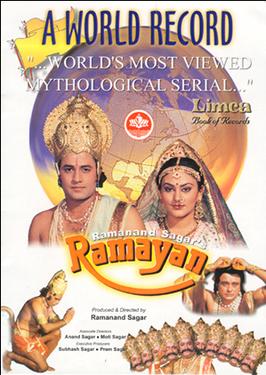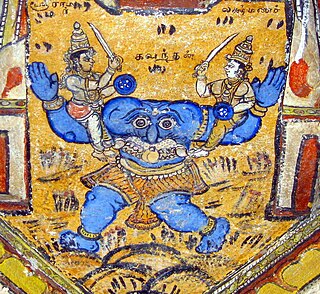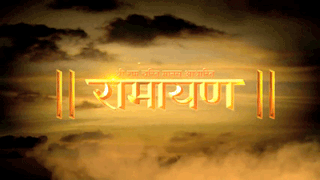Related Research Articles

Shatrughna is a prince of Ayodhya, King of Madhupura and Vidisha, and a brother of Prince Rama in the Hindu epic Ramayana. He is also known as Ripudaman. He is the twin of Lakshmana. He is a loyalist of Bharata, just like Lakshmana is to Rama. According to the Valmiki Ramayana, Shatrughna is an incarnation of the Sudarshana Chakra. Shatrughna also appears as the 412th name of Vishnu in the Vishnu Sahasranama of the Mahabharata.

In the Hindu epic Ramayana, Maricha, or Mareecha is a rakshasha, who was killed by Rama, the hero of the epic and an avatar of Vishnu. He is mentioned as an ally of Ravana, the antagonist of the epic. His most notable exploit is his role in the kidnapping of Sita, Rama's wife. His son Kalanemi was killed by Hanuman.

Sita, also known as Siya, Janaki, Maithili, Vaidehi and Bhumija, is a Hindu goddess and the female protagonist of the Hindu epic, Ramayana. She is the consort of Rama, the avatar of the god Vishnu, and is regarded as an avatar of Vishnu's consort, Lakshmi. She is also the chief goddess of Rama-centric Hindu traditions. Sita is known for her dedication, self-sacrifice, courage, and purity.

Bharata is a figure in the ancient Hindu epic Ramayana. He is the son of Dasharatha, the king of Kosala, and Kaikeyi, the daughter of King Ashvapati of Kekeya. He is a younger half-brother of Rama. He rules Ayodhya as its regent while Rama is banished from his kingdom, and fights to rescue his wife Sita, kidnapped by Ravana.

Shurpanakha, is a rakshasi (demoness) in Hindu epic. Her legends are mainly narrated in the epic Ramayana and its other versions. She was the sister of Lanka's king, Ravana, and the daughter of the sage Vishrava and the rakshasi Kaikeshi. Shurpanakha's role in the original epic is small, yet significant.

Manthara is a character in the Hindu epic Ramayana. In the epic, she is described to have convinced Queen Kaikeyi that the throne of Ayodhya belonged to her son Bharata and that her step-son—crown-prince Rama —should be exiled from the kingdom. She is portrayed as a mother-figure to Kaikeyi and her twin Yudhajit, following the banishment of their mother. She accompanied Kaikeyi to Ayodhya after her marriage to Dasharatha.

Ramayan is an Indian Hindi-language epic television series based on ancient Indian Sanskrit Epic Ramayana. The show was created, written, and directed by Ramanand Sagar. It originally aired between 1987 and 1988 on DD National and it was narrated by Ashok Kumar and the director Ramanand Sagar. The music was composed by Ravindra Jain. During its run, the show became most watched television series in the world, and it is the most watched serial in the world, it had a viewership of 82 percent. The repeat telecast was aired on 20 different channels in 17 countries on all the five continents at different times. The success of the series was documented well by the media. According to BBC, the serial has been viewed by over 650 million viewers. Each episode of the series reportedly earned DD National ₹40 lakh.

Ramayana: The Legend of Prince Rama is a 1992 anime film co-produced by Japan and India; produced and directed by Yugo Sako. It is based on the Indian epic Ramayana. The film was directed by Koichi Sasaki and Ram Mohan, with music composed by Vanraj Bhatia. The film was first released in India at the 24th International Film Festival of India. It was also screened at the 1993 Vancouver International Film Festival. Subsequently, a Hindi dubbed version was released in the late 1990s.

In Hinduism, Kabandha is a Rakshasa (demon) who is killed and freed from a curse by the god Rama – an Avatar of Vishnu – and his brother Lakshmana. Kabandha's legend appears in the Hindu epics Ramayana and Mahabharata, as well as in later Ramayana adaptations.

Ramayana: The Epic is a 2010 Indian Hindi-language computer-animated mythological action film from Maya Digital Media. Directed by Chetan Desai and produced by Ketan Mehta, it was released by Warner Bros. India on 15 October 2010.

Ramayan: Sabke Jeevan Ka Aadhar is an Indian television series produced by Sagar Pictures which aired on Zee TV. It is an adaptation of Ramcharitmanas.
Ramleela – Ajay Devgn Ke Saath, commonly known as Ramleela is a mythological on-stage musical drama, based on the famous Indian epic poem Ramayan. The show premiered on 21 October 2012 on Life OK and completed the story in five episodes on 18 November 2012. The show was narrated by Bollywood actor Ajay Devgn, who provided a prologue at the beginning of each episode or act. The show aired during the period from Dussehra in October till Diwali in November.

Sampoorna Ramayanam is a 1958 Indian Tamil-language Hindu mythological film directed by K. Somu. It is based on Valmiki's Ramayana. The film stars N. T. Rama Rao in the lead role of Rama and Sivaji Ganesan as Bharatha. It was released on 14 April 1958 and ran for over 264 days in theatres, thereby becoming a silver jubilee hit. The film was dubbed into Hindi as Ramayan in 1960.

Rama (Rāma), the hero of Ramayana, is described in the Jain scriptures as one of sixty-three illustrious persons, known as Salakapurusa. Among these, there are nine sets of Balabhadra, Vasudeva and Prati-Vasudeva. Rama was the 8th Balabhadra with Lakshmana and Ravana being his Vasudeva and Prati-Vasudeva counterparts. He is described as a young prince who is deprived of his throne and turned into a pauper. While living in exile his wife Sita is kidnapped by Ravana, King of Lanka. Rama then rescues Sita with the help of his brother Lakshmana and King Sugriva. Ravana is killed by Lakshmana and they both go into hell. Rama becomes a Jain muni and his soul attains moksha. Sita becomes a Jain sadhvi and is born into heaven as Indra.

Trijata is a rakshasi (demoness) in the Hindu epic Ramayana who is assigned the duty of guarding Sita who was kidnapped by the demon-king of Lanka Ravana. In later adaptions of Ramayana, Trijata is described as a daughter of Vibhishana, the brother of Ravana.

Siya Ke Ram is an Indian TV series on Star Plus produced by Nikhil Sinha under the banner of Triangle Film Company. This show presents the epic Ramayana, the story of Rama and Devi Sita from Sita's perspective. The show features Madirakshi Mundle and Ashish Sharma playing as Goddess Sita and Lord Rama, respectively, and Karthik Jayaram as Raavan. It premiered on 16 November 2015 and ended on 4 November 2016.

Ramayan is a Hindi TV series that was aired on Zee TV in 2001. It is a television adaptation of the ancient Indian epic of the same name, and is primarily based on Valmiki's Ramayana, Tulsidas Ramcharitramanas, Kalidasa's Raghuvaṃśa and Kambar's Kambh Ramayana. It was produced and directed by Baldev Raj Chopra and Ravi Chopra.

Ram Siya Ke Luv Kush is an Indian mythological drama television series, which aired on Colors TV from 5 August 2019 to 10 February 2020. The series focused on the story of Rama and Sita as well as their children Luv and Kush. It starred Shivya Pathania, Himanshu Soni, Krish Chauhan, and Harshit Kabra in lead roles.
Shrimad Ramayan is an Indian Hindi-language mythological television series that premiered on 1 January 2024 on Sony Entertainment Television. Produced by Siddharth Kumar Tewary under the banner of Swastik Productions, the series is based on the epic Ramayana. It stars Sujay Reu as Rama and Prachi Bansal as Sita.
References
- 1 2 3 4 "Mahavira Charita". Dictionary Of Indology. Pustak Mahal. 2009. p. 134.
- 1 2 3 Mirashi p.111
- 1 2 Pillai, S. Devadas (1997). Indian sociology through Ghurye, A dictionary. Popular Prakashan. p. 213.
- ↑ Mirashi p.146
- ↑ Mirashi pp.111-3
- ↑ Mirashi pp.113-6
- ↑ Mirashi pp.116-22
- ↑ Mirashi pp.122-9
- ↑ Mirashi pp.129-37
- ↑ Mirashi pp.137-42
- 1 2 3 Mirashi pp.142-4
- 1 2 3 Mirashi pp.144-6
- ↑ Mirashi pp. 146-8
- ↑ Mirashi p. 151
- ↑ "Bhavabuti". Dictionary Of Indology. Pustak Mahal. 2009. p. 32.
- 1 2 3 Das, Sisir Kumar (2005). A history of Indian literature, 500-1399: from courtly to the popular. A history of Indian literature. Sahitya Akademi. p. 56.
Books
- Mirashi, V. V. (1996). "The Mahavira-charita". Bhavabhūti. Motilal Banarsidass Publishers. ISBN 81-208-1180-1.
